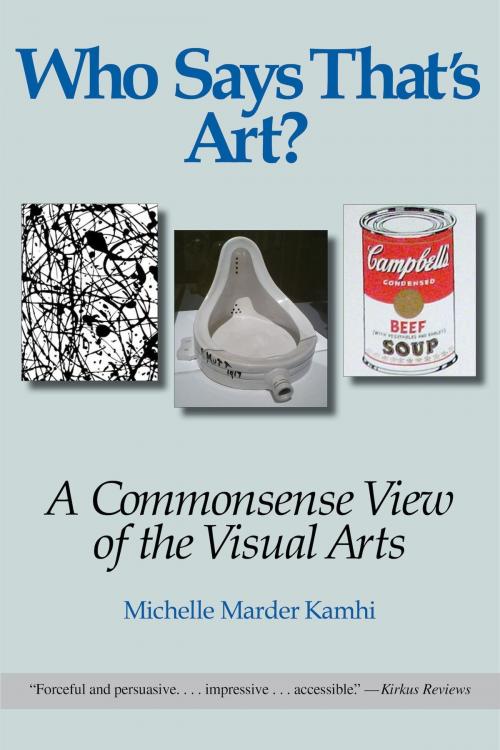Who Says That's Art? A Commonsense View of the Visual Arts
Nonfiction, Religion & Spirituality, Philosophy, Aesthetics, Art & Architecture, General Art, Criticism| Author: | Michelle Marder Kamhi | ISBN: | 9780990605720 |
| Publisher: | Michelle Marder Kamhi | Publication: | November 14, 2014 |
| Imprint: | Smashwords Edition | Language: | English |
| Author: | Michelle Marder Kamhi |
| ISBN: | 9780990605720 |
| Publisher: | Michelle Marder Kamhi |
| Publication: | November 14, 2014 |
| Imprint: | Smashwords Edition |
| Language: | English |
Today's artworld experts accept virtually anything as "art"—from all-black paintings and facsimiles of supermarket cartons to dead animals preserved in formaldehyde. Many art lovers reject such things, arguing that they are not art. This book explains why those ordinary people are right and the presumed experts are wrong.
Museums and galleries around the world are filled with "cutting-edge" contemporary work that art lovers largely detest, while painters and sculptors whose art the public would appreciate are ignored by the cultural establishment.
How did this happen? What mistaken ideas have led to it? Who is responsible? And what can be done to reverse the situation? Who Says That's Art? answers such questions—in commonsense terms that non-specialists can readily understand.
Many books have attempted to bridge the gap between the public and the contemporary artworld. What makes this book different? Other writers claim that people need to know the theories behind "advanced" work in order to appreciate it. Who Says That's Art? debunks those theories. Moreover, it reveals the cultural forces that collude to promote pseudo art in the contemporary artworld—from art educators and wealthy collectors to museum administrators and the media.
Drawing on evidence ranging from cognitive science to cross-cultural studies, the book explains how and why the traditional arts of painting and sculpture profoundly move us. In contrast, it demonstrates the emptiness of the "installations" and "conceptual art" that dominate the postmodernist artworld. Further, it documents the shallowness of the collectors who pay huge sums for works of contemporary "art" such as a shark in a tank of formaldehyde. Surprisingly, however, the author—unlike most conservative critics—argues that the breakdown of the visual arts actually began with the invention of "abstract art" in the early twentieth century, because it rendered art unintelligible.
In conclusion, Who Says That's Art? highlights the pleasures and rewards of genuine art, both old and new, and suggests how to restore sanity to the contemporary artworld.
Today's artworld experts accept virtually anything as "art"—from all-black paintings and facsimiles of supermarket cartons to dead animals preserved in formaldehyde. Many art lovers reject such things, arguing that they are not art. This book explains why those ordinary people are right and the presumed experts are wrong.
Museums and galleries around the world are filled with "cutting-edge" contemporary work that art lovers largely detest, while painters and sculptors whose art the public would appreciate are ignored by the cultural establishment.
How did this happen? What mistaken ideas have led to it? Who is responsible? And what can be done to reverse the situation? Who Says That's Art? answers such questions—in commonsense terms that non-specialists can readily understand.
Many books have attempted to bridge the gap between the public and the contemporary artworld. What makes this book different? Other writers claim that people need to know the theories behind "advanced" work in order to appreciate it. Who Says That's Art? debunks those theories. Moreover, it reveals the cultural forces that collude to promote pseudo art in the contemporary artworld—from art educators and wealthy collectors to museum administrators and the media.
Drawing on evidence ranging from cognitive science to cross-cultural studies, the book explains how and why the traditional arts of painting and sculpture profoundly move us. In contrast, it demonstrates the emptiness of the "installations" and "conceptual art" that dominate the postmodernist artworld. Further, it documents the shallowness of the collectors who pay huge sums for works of contemporary "art" such as a shark in a tank of formaldehyde. Surprisingly, however, the author—unlike most conservative critics—argues that the breakdown of the visual arts actually began with the invention of "abstract art" in the early twentieth century, because it rendered art unintelligible.
In conclusion, Who Says That's Art? highlights the pleasures and rewards of genuine art, both old and new, and suggests how to restore sanity to the contemporary artworld.















